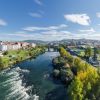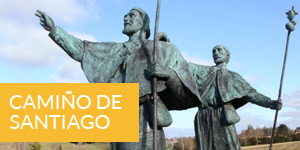- Accede I
- Regístrate I
- carrito
Rías Baixas - Salnés: Villas Marineras
Duración: 1 día completo
Itinerario: Pontevedra - Combarro - Sanxenxo - Portonovo - A Lanzada - O Grove -A Toxa - Cambados.
Descripción: La península del Salnés es el brazo de tierra que se adentra en el mar entre las Rías Baixas de Arousa y de Pontevedra, rías resguardadas, muy productivas, sembradas de bateas en las que crecen los mejores mejillones del mundo. El arte y la historia se combinan con el patrimonio popular y con los recursos turísticos de sol y playa. Aquí se encuentran ciudades como la monumental Pontevedra y la señorial Cambados; pueblos marineros, como Combarro, estampa típica de cruceros y de hórreos inmersos casi en el mar; lugares de veraneo como Sanxenxo, Portonovo y San Vicente do Mar; playas extensas como Montalvo o el inmenso arenal de A Lanzada; y la pequeña península de O Grove desde la que se accede a la selecta isla de A Toxa. Grandes monasterios y multitud de pazos y casas señoriales, completan la riqueza de una tierra que es además una de las principales regiones vinícolas de Galicia, productora de caldos Albariños y Barrantes.
Paradas recomendadas
Pontevedra-Combarro-Sanxenxo-Portonovo-A Lanzada-O Grove-A Toxa-Cambados
La excursión contornea la península del Salnés, entre las Rías Baixas de Arousa y de Pontevedra, rías resguardadas, muy productivas, sembradas de bateas en las que crecen los mejores mejillones del mundo, y de islas grandes y pequeñas: Ons, en la ría de Pontevedra, y Arousa, Sálvora, Cortegada y A Toxa, en la de Arousa. En las riberas del Salnés hay mucho arte e historia. En sus márgenes se asentaron ciudades hermosas como Pontevedra, pequeños pueblos marineros -Combarro, O Grove, Cambados-, centros turísiticos y residenciales -Sanxenxo, Portonovo, San Vicente do Mar-, monasterios -Poio, Armenteira-, y multitud de pazos y casas señoriales, que dan cuenta de la riqueza de una tierra que es además una de las principales regiones vinícolas de Galicia, productora de caldos Albariños y Barrantes.
Todo un mundo en miniatura, muy concurrido por gallegos y foráneos durante la época estival: por su agradecido clima, sus magníficas playas, sus sabrosos pescados y mariscos y la variedad de servicios turísticos.
El itinerario empieza en la monumental Pontevedra, al fondo de la ría del mismo nombre, y continúa en Combarro, estampa típica de cruceiros y de hórreos inmersos casi en el mar. Pasadas las playas de Sanxenxo, Portonovo, Montalvo, llega al inmenso arenal de A Lanzada, y después a la península de O Grove y a la atractiva y selecta isla de A Toxa. La excursión termina en la monumental Cambados.
Pontevedra
En el fondo de la ría del mismo nombre, y a orillas del río Lérez, el casco histórico de Pontevedra, de origen medieval, destaca por su buen estado de conservación. Aunque parece una ciudad pequeña, recorrerla siempre lleva más tiempo del esperado, porque son muchos sus encantos. El Museo Provincial, la Iglesia de A Peregrina (s. XVIII), barroca y con forma de vieira, la de Santa María a Maior (s. XVI), la recogida plaza de A Leña, los soportales de A Ferrería, o la calle de San Telmo, son sólo algunos de los puntos de interés de esta ciudad que es además capital de la provincia del mismo nombre.
Combarro
Combarro es la estampa de la Galicia marinera que uno espera encontrar. Sus casas y hórreos prácticamente metidos en el mar han sido inmortalizados en miles de fotos y carteles, construyendo la típica imagen de las rías gallegas. Combarro tiene la denominación oficial de Conjunto Histórico-Artístico.
Sanxenxo y Portonovo
Aunque hace poco más de medio siglo Sanxenxo y Portonovo eran sólo dos pequeñas aldeas de pescadores, hoy en día son las capitales del veraneo de Galicia. Sus playas y su movida nocturna son un fuerte imán para gallegos, resto de españoles y para los vecinos portugueses.
A Lanzada
A Lanzada es una inmensa lengua de arena blanca que mira al océano, gracias a la que la península de O Grove se mantiene unida a tierra firme. Pero es también, por su relación con los ritos de fecundidad, una playa profundamente vinculada al misticismo que se atribuye a los gallegos: la tradición asegura que tomar un baño de nueve olas durante una noche de luna garantiza la fertilidad. En su flanco sur, mirando al mar y a poniente, tiene una preciosa ermita románica (s. XIII) acompañada por los restos de una torre medieval (s. X).
O Grove
La península de O Grove, sólo levemente enganchada al continente, tiene en realidad personalidad isleña. Muy frecuentada en verano, es conocida principalmente por la calidad de sus mariscos, que la convierten en la capital de la gastronomía marinera. Pero también por lugares como el monte Siradela, que con sus 167 metros sobre el nivel del mar es el punto más elevado de la región y también su mejor mirador. Su centro urbano tiene multitud de tascas, tabernas y restaurantes donde sirven exquisitos mariscos y pescados.
Del puerto de O Grove sale el crucero que recorre la ría de Arousa y nos lleva tierra adentro hacia la boca del río Ulla. La ruta, según cuenta la leyenda, es la misma que siguió la barca que transportó los restos del Apóstol Santiago hasta Padrón. Se navega entre las bateas en las que se cultivan los afamados mejillones gallegos -Galicia es el primer productor mundial de estos bivalvos-.
Illa da Toxa
Isla lujosa, famosa por las propiedades de sus aguas, que dieron nombre a una marca de productos cosméticos y minerales internacionalmente conocidos. En 'La Toja' el ambiente es selecto, y los servicios turísticos -hoteles, balneario, casino- de primera calidad y con gran tradición, que en algunos casos datan de principios del siglo XX. Uno de sus atractivos es su peculiar capilla de San Sebastián, completame cubierta de conchas de vieira.
Cambados
Cambados ostenta el título de 'Muy Noble Villa'. Esa nobleza se aprecia en las centenarias piedras que componen la plaza de Fefiñáns (s.XVII), con su señorial pazo y la románica Iglesia de San Bieito (s.XVI) que la flanquea. Cambados es la capital indiscutible del vino Albariño, que celebra su fiesta el primer fin de semana de agosto.





















